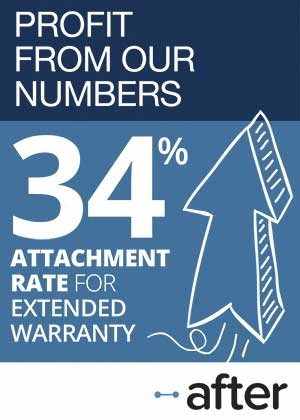Computer Warranties:
At the half-year mark, HP is up and Dell is down, while Apple and Seagate keep their warranty costs under control. At Lexmark and Palm, however, already-elevated warranty costs keep going higher.
U.S.-based computer manufacturers saw their first-half claims rise by $118 million to $2.7 billion, but because sales rose at a faster rate, the percentage of hardware revenue they used to pay claims actually decreased a bit from 2.9% to 2.7%.
Disk drive and data storage system vendors, meanwhile, as a group saw claims fall from $284 million in the first half of 2007 to $281 million in the first half of 2008. But because sales rose so swiftly, that tiny change in dollar terms translated into a -17% change in the claims rate, from 2.6% in the middle of 2007 to 2.1% in the middle of 2008.
For both industry segments, warranty accruals grew in dollar terms. Computer makers set aside $2.9 billion in the first half, while data storage vendors set aside $314 million. But again, because sales figure into the percentage calculations, the data storage companies saw accrual rates rise by 10% while the computer makers saw accrual rates fall by 4%.
HP Up; Dell Down
It was a mixed picture for the top computer manufacturers. Hewlett-Packard Co. turned in a claims rate of 3.3% and an accrual rate of 3.7%. Both were up from a year before (HP ends its half-year on April 30).
At Dell, the latest warranty claims rate is 2.0% and the latest accrual rate is 2.7%. The claims rate is down from a year before while the accrual rate is up (Dell ended its first fiscal quarter on May 2).
Apple Inc. continues to amaze. While continuing to sell its Macintosh family of personal computers, it launched completely separate families of iPod digital music players and iPhone mobile telephones, turning itself into not only a major computer brand name but also a presence in consumer electronics.
And while the company has taken its lumps for some well-publicized product defects, one can see in the data of Figure 1 that whatever crisis it faced in 2005 and 2006 is now behind it. Sales continue to increase but not warranty expenses. And since the claims and accrual rates are computed by comparing the expenses to the sales, the percentages are down in 2007 and so far in 2008.
Figure 1
Apple Inc.
Warranty Claims & Accrual Rates, 2003-2008
(in $ Mil & percentage of product sales)

It's a similar story at Seagate Technology, though for slightly different reasons. While Apple launched completely new product families and suffered the consequences of being a trendsetter, Seagate acquired a competitor (Maxtor) and initially struggled to control the combined product lines while lengthening some warranties to five years. One can almost date the merger (it happened in May 2006) from the doubling of claims from the first to the second quarters of 2006.
Figure 2
Seagate Technology
Warranty Claims & Accrual Rates, 2003-2008
(in $ Mil & percentage of product sales)
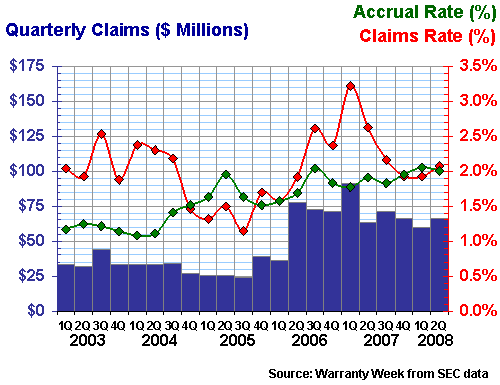
Ever since, Seagate's warranty claims have continued to be paid at those elevated levels, although the total dropped from $154 million in the first half of 2007 to $126 million in the first half of 2008. Warranties remain lengthy, yet the expenses have dropped. And because of sales gains, the claims rate as a share of revenue was down by a full half a percentage point, from 2.6% to 2.1%. The accrual rate, however, which signals future expectations, was up by a tenth of a percentage.
On two of the last three occasions Warranty Week checked in with the computer industry (the newsletters of June 27, 2008; September 18, 2007; and May 8, 2007), we profiled Apple and Seagate. This time, we're shifting the focus a bit to other computer companies that haven't been as frequently mentioned.
Elevated Warranty Expense Rates
While the computer, data storage, and peripherals manufacturers have collectively cut their first-half claims rate from 2.9% of revenue in 2007 to 2.6% of revenue this year, several of the best-known industry players are way over that mark. In the printer industry, Lexmark International has seen its claims rate exceed 14%, and in the handheld industry Palm Inc. has paid out as much as 8.6% of its hardware revenue in warranty claims.
Paradoxically, it's Lexmark that's probably in better shape. That's because we're figuring the claims rate using just the company's hardware revenue, and more than two-thirds of Lexmark's total revenue isn't hardware. It consists primarily of consumables such as ink and toner, which we suspect is not only a good recurring source of revenue, but also of profits. It would almost pay for Lexmark to sell the printer hardware at or below cost, and make it up in the aftermarket on the consumable sales.
If we were counting all of Lexmark's revenue in the calculations, its claims rate would be below 4% and its accrual rate would be below 5% for the first half of 2008. Those are high, but not unmanageably high.
Still, as can be seen in Figure 3, there can be too much of a good thing. While in the years 2003 to 2006 the company's claims rate never exceeded 11% of hardware revenue, in the 18 months since it's never been below 11%. More worrying is the accrual rate, which is the amount entered onto the balance sheet as an expense. Over the past 18 months, only once has it been below 18%, which means the company is expecting to spend more than one-sixth of its hardware revenue on hardware repairs or replacements. That's going to consume a lot of consumable profits.
Figure 3
Lexmark International Inc.
Warranty Claims & Accrual Rates, 2003-2008
(in $ Mil & percentage of product sales)
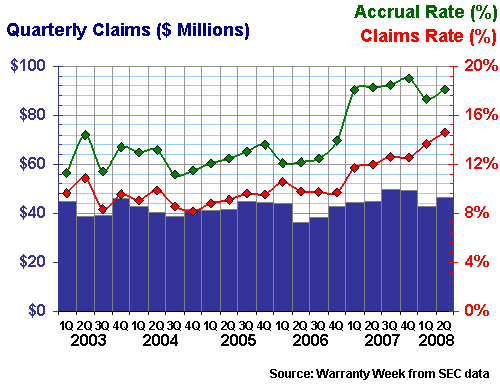
At Palm, the claims and accrual rates are lower, but the problem is that the company doesn't have anything else to fall back on besides its hardware. It spun off its software operations years ago, and it's never had a stake in carrier services. And there aren't much in the way of consumables or aftermarket revenue streams coming its way after the hardware is sold.
Also, as in Figure 3, the worrying trend in Figure 4 is upward -- from the low at the end of 2003 to the peak in mid-2005 to the 8% levels seen in the past year. And although a sales decline and price cuts explain part of the climb in the claims rate, it doesn't explain away the accompanying rise in the accrual rate. That is supposed to measure the predictions by the company of what it expects to pay in future repair costs. And by the looks of it, Palm expects costs to keep rising.
Figure 4
Palm Inc.
Warranty Claims & Accrual Rates, 2003-2008
(in $ Mil & percentage of product sales)
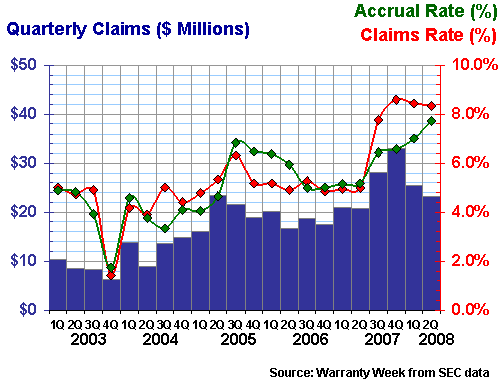
At EMC, the claims rate is up 15% in the year to June 2008 and the accrual rate is up 27%. But the company is still absorbing the warranty expenses of the acquisition it made of Iomega Corp. in April, so perhaps that's a contributing factor. Then again, in the months before the acquisition, Iomega was reporting warranty claims and accrual rates in the range of 1.5% to 2.5%, so perhaps other homegrown forces are also partly to blame.
Figure 5
EMC Corp.
Warranty Claims & Accrual Rates, 2003-2008
(in $ Mil & percentage of product sales)
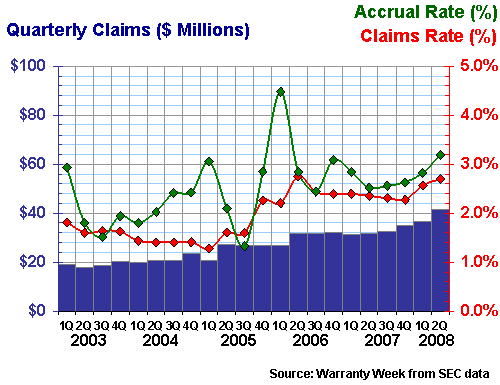
Adaptec is in a similar line of business -- large storage systems for business -- though it's almost 50 times smaller than EMC. Still, what's notable about the data in Figure 6 is how far below the company's warranty expenses now are, compared to their peak in the middle of 2007.
Adaptec actually sold off part of its network storage product line in June to Overland Storage Inc. That sale, however, won't begin to show up in the charts of either company until at least the end of the third quarter, for which financial reports are expected in November.
Figure 6
Adaptec Inc.
Warranty Claims & Accrual Rates, 2003-2008
(in $ Mil & percentage of product sales)

Quantum Corp., like Seagate Technology, is more into the component end of the storage business than the complete systems end. If this were the automotive business, it would be a powertrain supplier, making transmissions or axles or engines. And just as in the automotive business, it's the OEMs that pay out the most in warranty claims, followed by their powertrain suppliers.
It's therefore no shock to see Quantum in the high numbers, peaking with a claims rate of 7.3% in early 2003 and an accrual rate of 4.4% in early 2005. What's encouraging, however, is the slow but steady decline observed since then. At the halfway point of 2008, Quantum's warranty claims rate was down 22% and its accrual rate was down almost 9% from a year before.
Figure 7
Quantum Corp.
Warranty Claims & Accrual Rates, 2003-2008
(in $ Mil & percentage of product sales)
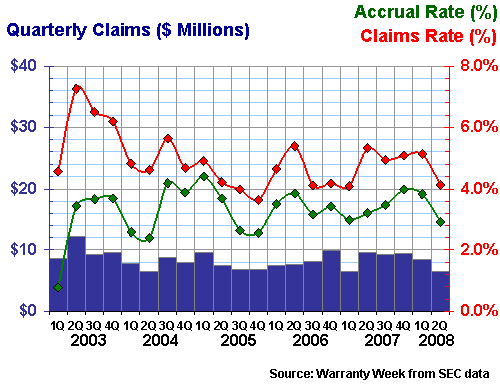
Finally, we present the warranty track record of SanDisk Corp. for the first time. The company, a pioneer in the business of flash drives, memory cards, and digital music players, displays what can only be called a curious 180-day polarity in its warranty expenses. In the spring and fall, its warranty accrual rate soars, and in the summer and winter it plummets. One could mistake it for the trail left by a ball bouncing down a staircase.
Figure 8
SanDisk Corp.
Warranty Claims & Accrual Rates, 2003-2008
(in $ Mil & percentage of product sales)
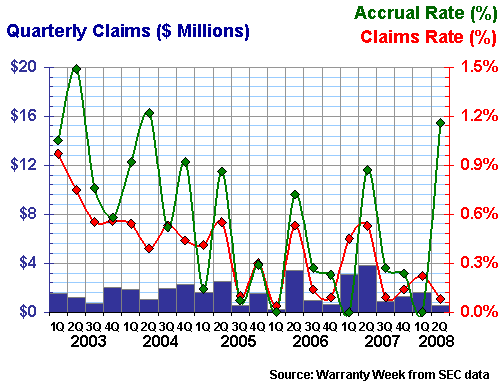
Unlike some of its competitors in the flash memory sector, SanDisk doesn't pretend that its product will last forever by backing them with "lifetime" warranties. SanDisk provides much more realistic two-to-five-year warranties on its products, which on the one hand limits its liability to a finite term and on the other hand keeps its expenses manageable. Or does it?
The highs and lows seen in Figure 8 aren't all that extreme, when one considers that everything on the chart is within a 1.5% range from the highest point to the lowest point. Some of the other companies have seen bigger swings within a single year. And it's certainly not in a Palm-like bind where repair costs are high and sales are falling. But measured June-to-June, the company's accrual rate is up 33% and its claims rate is down 85%. And its warranty reserve fund has grown in size by more than 60%. Clearly, all the balls are bouncing in different directions.






